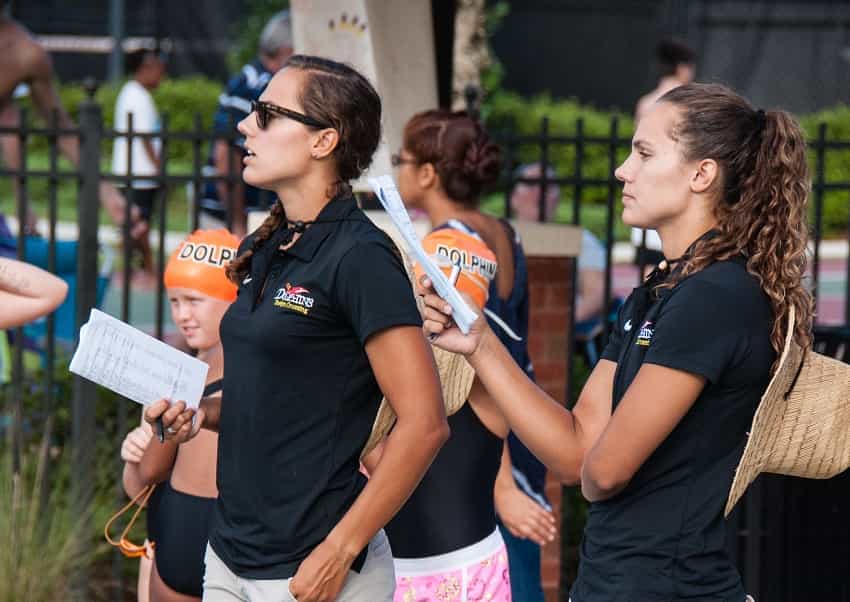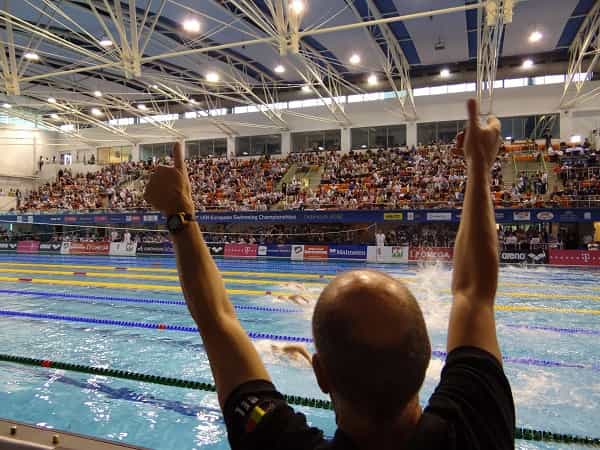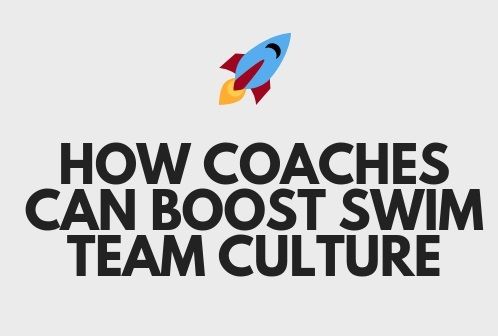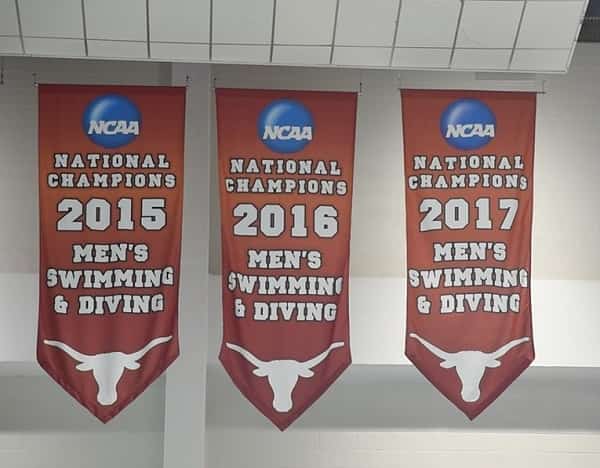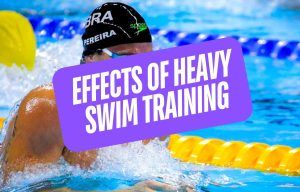While the United States is always expected to perform well in swimming at the Olympics, there were some indications that things might not go so hot for them in Rio in 2016.
The US Olympic Trials, held a few weeks before the Games, had been decidedly underwhelming.
Part of this was the pressure—every session at Trials was a sold out madhouse (compared to Rio where there were plenty of empty seats), and partly environmental with crowded and over-chlorinated pools.
But the time between Trials and the Games saw the team come together in a big way.
In Rio the team clanged cowbells every time one of their swimmers went to the ready room before a race. There was the viral follow-up to 2012’s Call Me Maybe, this time a riff on the popular carpool karaoke. And there were the 45-minute “ice breaker” sessions spearheaded by Stanford coach Greg Meehan that almost always descended into a barrel of laughs.
The team-first attitude was visible from first-time team captain Michael Phelps, who would talk with swimmers after races. Elizabeth Beisel, a three time Olympian, said at the first team meeting, “I swim day one, and after that I’m going to give you guys everything I have.”
Quotes from other swimmers on the team exemplified the team dynamic that helped US swimmers perform at their best that week:
- Stanford sprinter Simone Manuel, who would win four medals, including gold in the 100m freestyle: “We’re a family, and it’s a great support system.”
- Josh Prenot, Cal breaststroker who won silver in the 200m breaststroke: “It’s a huge thing. I’ve never seen this on the national team before.”
The performance of the team in Rio surpassed expectations, with the swimmers collecting a staggering 33 medals (23 more than second place Australia), with breakout performances across the board.
“It’s going to go down as one of the greatest Olympic performances ever, and we weren’t forecast for that,” said men’s head coach Bob Bowman.
The Not-so-Hidden Impact of Team Culture
How swimmers behave, train, compete and feel are all impacted by the culture.
We’ve all experienced the rush and confidence of being on a team that is geared towards supportive relationships, psychologically safe, and promotes excellence and fun. There’s a strong sense of togetherness and purpose.
And of course there is the flip side: the team where it’s a group of individuals. Bad body language is rife through the team, swimmers don’t correct and help each other when someone stumbles or screws up and there is a lack of purpose. It’s easy to see how teams like this are not motivating and not very fun.
The Power of Together
Just how effective is the feeling of togetherness when it comes to improving performance?
Here’s a study to exemplify just how powerful it is.
Researchers at Stanford performed a simple experiment to see if just thinking you were a part of a team would influence things like intrinsic motivation and resilience.
Participants were asked to complete a challenging puzzle and were split in two groups.
The “together” group was told they’d work the puzzle on their own for a few minutes, and then would get help from someone else working on the puzzle. The “solo” group were instructed to complete the puzzle on their own.
The “together” group worked harder, worked longer, and even had greater enjoyment of the task. A couple weeks later they were even more likely to work on a related task compared to the solo group.
As the study authors noted, the feeling of togetherness had “turned work into play.”
Swimmers can identify with this–they spend large bouts of training in silence, with nothing but the black line to keep them company. It can feel lonely, especially during those nerve-wracked few moments when they are standing alone behind the block.
This tells us something we likely already know: Together we are stronger.
Instead of leaving culture to decide itself, or risking the chance that it would develop on its own (whether good or bad), here are things that coaches can do in order to supercharge culture and performance.
Over-communicate on expectations.
The beginning of the year is generally when swimmers are sat down and told what the expectations of them are for the year. No matter how rousing the speech your words will fade through the long slog of the season.
If it’s valuable to your culture, there’s little risk in over-communicating these expectations.
Apathy grows in the gaps where the athlete doesn’t know what is expected or when the message fades.
Each day swimmers should be reminded what is expected of them. It’s easy to think that they should “know” or that they should remember on their own, but over-communicating on the important stuff is critical. If it matters, it’s worth over-communicating on.
Set the standards early.
The beginning of the season or training cycle is a perfect time to lay down the expectations of athletes and the group. Inconsistency in messaging and standards,
In a post I wrote recently that provided suggestions for swimmers and what they can do to help foster a high-performance team culture I talked about the importance of welcoming newbies to the team and sharing the nature of what the team expects.
Having the standards set early lessens confusion later. Don’t wait until later to decide on team values.
Two-way feedback.
Yes, I know—we’re the coach, they are the swimmer. But vulnerability plays a massive role in culture. It’s not a position of weakness. It allows swimmers to drop the need to look tough and other various ego-centric issues and allow everyone to get to work.
Opening the door to allow swimmers to provide feedback also opens the door to them figuring out (ideally on their own) some of the things that they are doing that can help you coach them better.
Make it clear with your swimmers that this is a group and team effort and that feedback is encouraged.

Brendan Heller — Head Swim Coach, Sacred Heart (Greenwich) and Riverside Yacht Club.
The environment tells swimmers what is possible.
When swimmers walk out onto the pool deck what kind of cues and signals does the environment give them?
When championship banners line the rafters, trophies line the display case, and reminders of the expectations (“Train like a champion today”) held of athletes are visible, the environment says, Excellence is possible here. Excellence is expected here.
While these cues seem small, they help to create expectations by way of the environment. The banners, trophies and motivational slogans aren’t just to honor past accomplishments, but they also signal present expectations: This is what we’ve done. This is what we are capable of. This is who we are.
New team? On the up with your squad? You don’t need to a ten time state champ to promote expectations in the environment. Throw up signs/posters that signal the team values and expectations: Excellence is what we do here. Excellence every day, in every way. Swim like a champion today. And so on. Put these signals on your t-shirts, your swim equipment, your assistant coach’s forehead, etc.

Eddie Reese, Head Coach, University of Texas.
Be consistent with expectation.
Consistency, consistency, consistency. Shifting expectations creates a wavering sense of belief.
What are we for? What is our goal here?
If goals are constantly shifting, being adjusted, or being forgotten completely it creates a sense of un-seriousness that is hard to bounce back from.
If you set a standard of the group hitting 95% attendance at the beginning of the year, and then stop taking attendance a month in, you’re signalling that maybe this goal isn’t so important.
If you have different expectations for different athletes it creates an environment where athletes aren’t sure what is expected of them.
Standards become meaningless if they are applied in a different way to various athletes.
Evaluate with the group.
After action reports (AAR) are commonly used in successful organizations, whether big corporations or elite military units. They seek to gain awareness and feedback on performance. They ask simple questions that can kick-start difficult conversations that produce positive direction and momentum:
What are we doing well? Where can we improve? What’s the plan to get better together?
This isn’t about pointing fingers—an ideal team or group situation is where an athlete can point the finger at themselves and say, “Yup, that was my bad. I didn’t show up on that swim.”
It can take time and a barrage of questions to get there, but those awkward questions typically end up in better performances down the road.
Team evaluations are a part of helping athletes gain awareness and the power in knowing what can be changed and what to do moving forward.
Create an environment that encourages failure in the pursuit of improvement.
You know the Perfectionist swimmer?
The one who is terrified of going all-out during the main set because they worry about not matching up to what’s expected?
It stinks being that swimmer–who worries about letting down their teammates, their coach, and themselves by not excelling when it matters most. In the years I have been running my newsletter, periodically asking swimmers what they struggle with the most mentally in the water, these particular pain points come up at a staggering frequency. Sure, the Perfectionist swimmer worries about failing in general, but it’s the disappointing their peers and coaches that keeps popping up.
Awesome team culture (and faster, less anxiety-induced swimming) happens when swimmers can fail safely in front of their peers and coaches. When Google did research on which of their teams and groups performed best, the top factor was far and away psychological safety. Successful teams were comfortable taking risks and being vulnerable.
This means that teammates don’t ridicule one another for doing extra, there’s a proactive and less adversarial approach to conflict, and there are open lines of communication.
Build a climate that tolerates and encourages failure in the pursuit of excellence. This comes via your standards, team values, and the day-to-day communication.

Mike Koleber — Head Coach, Nitro Swimming
Listening 2.0.
Crossing our arms, brows furrowed and “listening” while interjecting isn’t really listening.
Instead, focus on leading the swimmer to elaborate before answering will help clarify misunderstandings and open both of you up to answers that might otherwise remain buried.
How many times have you tried relating a problem to someone only to have them interject and say something along the lines of, “Well, I had the same problem and did this…”
Suggestions only become meaningful once you have attained a “scaffold of thoughtfulness.”
Correct on the fly.
Sir Alex Ferguson, the legendary Manchester United football coach, notes that criticism is best levied as quickly as possible, and not off in the distance after the performance has faded.
“I would do it right after the game. I wouldn’t wait until Monday. I’d do it, and it was finished. I was on to the next match,” said Ferguson.
Bob Bowman, Michael Phelps’ long time coach, was similar in his approach of correcting athletes—whether it was technique or effort—mid-session rather than later or down the road.
“I’ve learned that the best way to get somebody to improve or to reinforce good behavior or to extinguish bad behavior is in the trenches,” says Bowman in his book The Golden Rules.
The sooner swimmers know what to fix, the sooner they can get to fixing them.
And of course… Purpose.
Thought I forgot about this one, didn’t ya? Nope.
A shared goal or purpose unites the team. It gives them something to rally around and focus on over the course of the season.
What’s our goal here? What are we capable of? What do we stand for as a group?
Create team and group goals that are unique to the team, meaningful, and measurable. Vague team goals invite vague effort. Be specific about what your purpose is and chase it relentlessly day after day in the water and on the pool deck.
Josh Prenot, the Cal breaststroker mentioned earlier, notes that the culture he experiences at Cal Berkeley, one of the dominant NCAA programs year in and year out, is one of the reasons for their success.

Josh Prenot — 2016 Olympic silver medalist, NCAA Champion
The Next Step
Having epic team culture is the closest you can get to putting high-performance swimming on auto-pilot.
A great culture raises everyone’s potential and effort (coach included), makes for an enjoyable training environment, and makes your club a desirable place for parents to send their swimmers.
When there is a strong sense of togetherness, respect and safety success in the water is almost inevitable.
More Stuff Like This:
10 Things Swimmers Can Do for Exceptional Team Culture. A swim team’s culture can boost your chances of success in the water just as easily as it can hold you back. Here’s how you, the elite-minded swimmer, can do your part to create exceptional team culture.
If You Wanna Go Faster, Train with Faster Swimmers. The people you train with have a strong effect on what kind of effort you are going to give at practice today. Here’s some interesting research on why you should choose to swim with the faster swimmers on your team.

